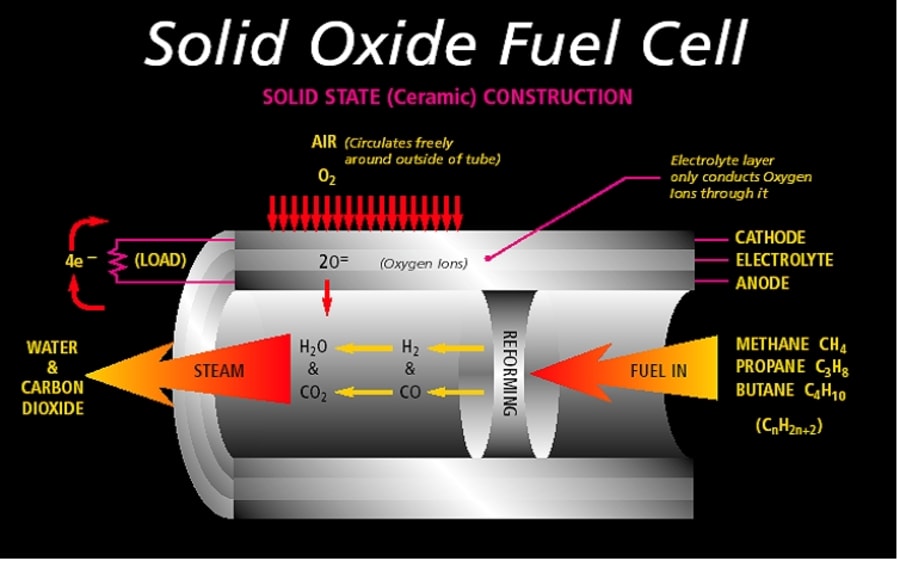PRACTICAL LARGE SCALE SOLID OXIDE FUEL CELLS Solid oxide fuel cells (SOFC) are extraordinarily efficient, regularly achieving fuel conversion efficiencies of 80% (heat and electricity). The pollutants from these electrochemical devices are almost zero and the CO2 discharged is about half of traditional power generating methods. Another compelling advantage is the ability to utilize many different fuel sources. Virtually all conventional hydrocarbon fluids can power a SOFC. Biogas from sewage treatment plants and landfill sites are common renewable energy examples. See Illustration #1 The source of these remarkable advantages lies in the fact that 100% inorganic materials (ceramics) are used in the cell’s construction. This, in turn, enables operation at high temperatures. At these higher temperatures, efficiencies increase and ordinary hydrocarbon fuels can be converted into Hydrogen (needed for the electrochemical reaction of the fuel cell) directly, inside the cell proper. To date individual cells have been limited to about 400 Watts per cell because of the difficulty in fabricating large area ceramic sheets which are used in the construction of the fuel cell. Even when individual cells are stacked to increase output the practical limit is about 8kW per stack. The root of the problem lies in the difficulties encountered attempting to manufacturing large area, thin, fired sheets of ceramic which form the elements of the cell. They tend to curl and “potato chip” upon firing. It has been discovered that most of the curling experienced is related to the method used to form the ceramic sheets while still in the “green” or unfired state. By far, the most popular sheet forming method has been based upon doctor-blade casting techniques. Unfortunately, this slip casting process causes non-isotropic conditions. Use of low viscosity slips and drying from only one side causes the top surface of the sheet to be binder rich. Additionally, Stoke’s law settling effects causes more of the finer size ceramic particles to congregate near this top surface. The end result is a curling effect upon firing, limiting the size of the sheets which can be processed successfully. A low cost, high volume process has been developed which alleviates this curling problem. This process is called high shear compaction. This process relies on very high shearing forces for complete isotropic dispersion of all particles. Similarly, the binder (necessary for forming the shape of the green sheet until it is fired) is uniformly dispersed. In a secondary step a twin roll extrusion process is used for high throughput and very accurate sheet thickness control. The sheets thus produced are completely isotropic, very uniform in thickness, with almost no limit on the size of the sheet which can be produced. See Illustration #2 The result is a continuous high speed forming process that accurately forms ceramic sheets to almost any desired width. The resultant sheets fire flat enabling the fabrication of large scale SOFCs for very efficient and green power generation. See Illustration#3 Please contact the writer for detailed information about this unique proprietary process.
Voting
-
ABOUT THE ENTRANT
- Name:William Belko
- Type of entry:individual
- Profession:
- Number of times previously entering contest:never
- William's favorite design and analysis tools:CAD
- For managing CAD data William's company uses:SolidWorks PDMWorks
- William's hobbies and activities:Organic gardening, skiing, fly fishing
- William belongs to these online communities:NASA tech briefs
- William is inspired by:underlying elegant simplicity
- Hardware used for this entry:Various machine toolsSoftware used for this entry:CAD
- Patent status:none








